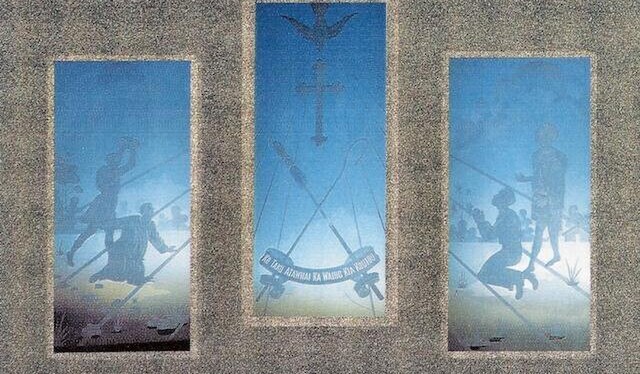SYMBOLS OF RECONCILIATION
In 1989 after lengthy negotiations the Mokomoko whānau, together with Whakatōhea led by Monita Delamere (later to be Sir Monita), were allowed to exhume, from Mt Eden jail, Mokomoko's remains, together with other bodies executed at the same time, and return them to Waiaua Marae. A year later the headstone was unveiled and finally in 1993 a pardon was issued by the Governor general and presented by the Minister of Justice to the Mokomoko whānau at Waiaua Marae. At a later date the church was asked if the Pardon could be kept in the church not only for safe keeping but as a symbol of healing and reconciliation between Māori and Pākehā in this area. This can be seen in the church porch. In keeping with this spirit of reconciliation, the wider Anglican Church in Aotearoa, New Zealand and Polynesia decided to commemorate both Carl Vōlkner and Te Whakatōhea chief Mokomoko as "symbols of reconciliation". Thus on March 2 every year the Church remembers and honours them.
Recognising the overall history of this church, the pain, the sorrow and the humiliation, followed by the healing and reconciliation that had taken place in latter years, vestry decided, in 1995, to ask the Waiapu Diocesan Synod if the church could be renamed to continue the healing process. This request was granted and the Church of Hiona St. Stephen became a reality, recognising both the hurt and the healing surrounding this historic building.This journey continued towards the recognition of the 150 years since the church was built. In preparation for commemorating the 150th Anniversary of the completion and dedication of the church the Vicar of the time, The Rev'd Arthur Bruce and vestry supported by the prayers of the local Minister's Association, sought the aroha and guidance of God. They wished the Sesquicentennial held at Easter 2014 to provide another step in the bi-cultural journey as a tikanga rua church in Ōpōtiki.As a response to the Bill passed by Parliament in late 2013 restoring the mana and character of Mokomoko, as the service of worship began a pare over the entrance of Hiona St Stephen was unveiled and blessed. It portrays Völkner (Wakana) and Mokomoko exchanging a hongi and holding a Bible. The inscription for the pare is:
Ka mea a Ihu, ‘Kia ū ki tōku aroha’ Hoani 15: 9b / Jesus said, ‘Abide in my love’ John 15: 9b
- The ornately carved prayer desks above the Chancel steps.
- The Bishop's chair and Prayer desk made out of twelve native timbers which, except for the kauri, were obtained from the same property that the original wood for the church was milled from in the 1860's.
- The oak Litany desk and Sanctuary chair were gifts from the old St. Mark's church, Wellington.
- Photographs of the early church are on the back wall.
- Tukutuku panels and Taniko kneelers in the Sanctuary.
- Reverend Carl Vōlkner's Bible and Prayer book together with the original Chalice and Paten used in 1865, all displayed in the glass show case on the north wall in front of the original pulpit.
- In the porch is a copy of the original contract and facing the main entrance is Mokomoko's Pardon
- The pare is on the door lintel at the entrance of the church.
- My Peace I leave with you. John 14:27)

Please feel free to wander round our church experiencing the peace to be found here. A peace that has been gained by the people of Christ working together and proclaiming the love of God, worshiping as one family.
No reira waiho ko te aroha o Te Matua
Kaha Rawa hei korowai mōu
Let the love of Almighty God unfold you.

